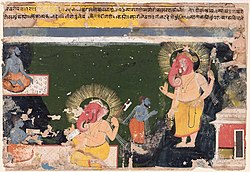Mahabharata
| Hindu texts |
Śruti
|
The Mahābhārata (/məhɑːˈbɑːrətə/;[1][2] Sanskrit: महाभारतम्) is one of the two major Sanskrit epics of ancient India and Hinduism written by saint Vyasa, the other is the Rāmāyaṇa.[3] It tells of issues between two groups of cousins in the Kurukshetra War. It also tells the fates of the Kaurava and the Pāṇḍava princes and their successors.
The Mahābhārata includes philosophical and devotional material. It has a discussion of the four "goals of life" or puruṣārtha (12.161). The stories in the Mahābhārata include the Bhagavad Gita, the story of Damayanti, the story of Shakuntala, the story of Pururava and Urvashi, the story of Savitri and Satyavan, the story of Kacha and Devyani and the story of Rishyasringa. It also has a shortened version of the Rāmāyaṇa.
The Mahābhārata is normally said to be written by Vyāsa. Most of it was probably put together between the 3rd century BCE and the 3rd century CE. The oldest parts o it are not much older than around 400 BCE.[4][5] The text probably became in its final form by the early Gupta period (c. 4th century CE).[6][7]
The Mahābhārata is the longest epic poem known. It has been said to be "the longest poem ever written".[8][9] Its longest version has over 100,000 śloka or over 200,000 individual verse lines. It also has and long sections of prose. The Mahābhārata has about 1.8 million words in total. It is about ten times the length of the Iliad and the Odyssey combined, It is about four times the length of the Rāmāyaṇa.[10][11] The importance of the Mahābhārata to world civilization has been compared to that of the Bible, the Quran, the works of Homer, Greek drama, or the works of William Shakespeare.[12] It is sometimes called the fifth Veda.[13] These sections deal with a number of topics such as a number of aspects of Hinduism, Hindu mythology, ethics, and the Hindu way of life. There is also a nineteenth section named Harivamsha. The Bhagavadgita, a dialogue between Krishna and Arjuna, is a part of the Mahabharata.
Sage Vyasa taught this epic to his son Suka and his students Vaisampayana and others. King Janamejaya, the son of Parikshit and grandson of the heroes of the epic, performed a great sacrifice (yajna). The epic was retold by Vaisampayana to Janamejaya at the advice of Vyasa. Later on, the other sage Suta retold the Mahabharata similar to Vaisampayana to Janamejaya, to Saunaka and others, during a sacrifice performed by Saunaka in Naimisaranya, which is near Sitapur in Uttar Pradesh.
Parvas
Noted below are few words about the eighteen sections of the Mahabharata. In Mahabharata, these sections are called parvan. A parvan means a book. The names of all parvas or books of the Mahabharata are noted below.
| Parva | Title | Contents |
| 1 | Adi-Parva | Introduction, birth and growing up of the princes. |
| 2 | Sabha-Parva | Life at the court, the game of dice, and the exile of the Pandavas. Maya Danava erects the palace and court (sabha), at Indraprastha. |
| 3 | Aranyaka-Parva (also Vanaparva, Aranyaparva) | The twelve years in exile in the forest (aranya). |
| 4 | Virata-Parva | The year in exile spent at the court of King Virata. |
| 5 | Udyoga-parva | Preparations for war. |
| 6 | Bhishma-parva | The first part of the great battle, with Bhishma as commander for the Kauravas. |
| 7 | Drona-parva | The battle continues, with Dronacharya as commander. |
| 8 | Karna-parva | The battle again, with Karna as commander. |
| 9 | Shalya-parva | The last part of the battle, with Shalya as commander. |
| 10 | Sauptika-parva | How Ashvattama and the remaining Kauravas killed the Pandava army in their sleep (Sauptika). |
| 11 | Stri-parva | Gandhari and the other women (stri) lament the dead. |
| 12 | Shanti-parva | The crowning of Yudhisthira, and his instructions from Bhishma |
| 13 | Anusasana-parva | The final instructions (anusasana) from Bhishma. |
| 14 | Ashvamedhika-Parva | The royal ceremony of the Ashvamedha conducted by Yudhisthira. |
| 15 | Ashramavasika-Parva | Dhritarashtra, Gandhari and Kunti leave for an ashram and eventual death in the forest. |
| 16 | Mausala-parva | The infighting between the Yadavas with maces (masala). |
| 17 | Mahaprasthanika-parva | The first part of the path to death (mahaprasthana or ‘the great journey’) of Yudhisthira and his brothers. |
| 18 | Svargarohana-parva | The Pandavas return to the spiritual world (svarga). |
| 19 | Harivamsha | Life of Krishna. |
The Pandavas
Kunti wants to fulfil her maternal expectations, but she has no man. She recollects the moment when her first son Karna was conceived from an arcane mantra which had given her once. Surya, the Sun God, appeared to her then. Thus, Kunti remembers her secret mantra and gives birth to the three sons – Yudhistra, Bhima and Arjuna. Yudhisthira’s father was god Yama, Bhima’s father was god Vayu, and Arjuna's father was Indra.
Madri, the second wife of Pandu, gave birth to two other sons - the twins, whose fathers were Ashwins (divine twins). Madri's sons are Nakula and Sahadeva.
These all are called the five Pandavas.
Donation for it's compilation
In the year 1932, The Bhandarkar oriental research institute located in Pune, needed money for the compilation and publication of the Holy Mahabharata and a guest house. A formal request was made to the seventh Nizam of Hyderabad State, Mir Osman Ali Khan who in no time released a farman to donate Rs.1000 per year for a period of 11 years.
Whereas, Rs. 50,000 was offered for the guest which is known as "Nizam guest house".[14]
Mahabharata Media
Vyasa narrating the Mahābhārata to Ganesha from a 17th century Mewar manuscript.
Map of some Painted Grey Ware (PGW) sites.
Shantanu falls in love with Satyavati, the fisherwoman. Painting by Raja Ravi Varma.
Draupadi with her five husbands – the Pandavas. The central figure is Yudhishthira; the two on the bottom are Bhima and Arjuna. Nakula and Sahadeva, the twins, are standing. Painting by Raja Ravi Varma, c. 1900.
Related page
More information
References
- ↑ "Mahabharata" Archived 2016-07-29 at the Wayback Machine. Oxford Dictionaries Online.
- ↑ "Mahabharata". Random House Webster's Unabridged Dictionary,
- ↑ Datta, Amaresh (1 January 2006). The Encyclopaedia of Indian Literature (Volume Two) (Devraj to Jyoti). ISBN 978-81-260-1194-0.
- ↑ Austin, Christopher R. (2019). Pradyumna: Lover, Magician, and Son of the Avatara. Oxford University Press. p. 21. ISBN 978-0-19-005411-3.
- ↑ Brockington (1998, p. 26)
- ↑ Pattanaik, Devdutt. "How did the 'Ramayana' and 'Mahabharata' come to be (and what has 'dharma' got to do with it)?". Scroll.in.
- ↑ Van Buitenen; The Mahabharata – 1; The Book of the Beginning. Introduction (Authorship and Date)
- ↑ James G. Lochtefeld (2002). The Illustrated Encyclopedia of Hinduism: A-M. The Rosen Publishing Group. p. 399. ISBN 978-0-8239-3179-8.
- ↑ T. R. S. Sharma; June Gaur; Sahitya Akademi (New Delhi, Inde). (2000). Ancient Indian Literature: An Anthology. Sahitya Akademi. p. 137. ISBN 978-81-260-0794-3.
- ↑ Spodek, Howard. Richard Mason. The World's History. Pearson Education: 2006, New Jersey. 224, 0-13-177318-6
- ↑ Amartya Sen, The Argumentative Indian. Writings on Indian Culture, History and Identity, London: Penguin Books, 2005.
- ↑ W. J. Johnson (1998). The Sauptikaparvan of the Mahabharata: The Massacre at Night. Oxford University Press. p. ix. ISBN 978-0-19-282361-8.
- ↑ Fitzgerald, James (1985). "India's Fifth Veda: The Mahabharata's Presentation of Itself". Journal of South Asian Literature. 20 (1): 125–140.
- ↑ "Reminiscing the seventh Nizam's enormous contribution to education".








